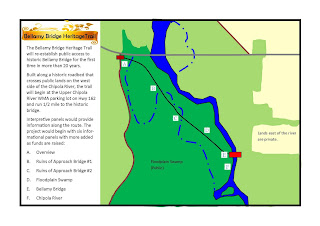 |
| Bellamy Bridge in Jackson County, FL |
I've had many questions since the story broke and thought I would try to answer some of them here by providing you with basic information on the project. Be sure to visit my primary Bellamy Bridge page at www.exploresouthernhistory.com/bellamybridge for more information after reading this article!
Here are the basics...
 |
| Route of Planned Bellamy Bridge Heritage Trail |
The steel-frame bridge was built in 1914 and is the second oldest bridge of its type in Florida and one of the ten oldest bridges in the state. It was originally built by and is still owned by Jackson County, but public access to it has been closed for nearly two decades.
While the old bridge itself will mark the 100th anniversary of its construction in 2014 and is a significant historic landmark in its own right, it is perhaps best known as the centerpiece of one of Florida's best known ghost stories: The Legend of the Ghost of Bellamy Bridge.
 |
| West End of Bellamy Bridge Where the Planned Trail will End |
While many people have heard of the ghost story, most do not realize that the historical significance of the Bellamy Bridge site goes far beyond the much loved folk tale. In fact, the crossing site where the bridge stands today has been in use for more than 300 years.
The first recorded use of the crossing took place in September 1686, when the Spanish expedition of Marcos Delgado crossed the Chipola River at the Bellamy site. He had been ordered to investigate reports of French intrusion on Spanish lands and marched west from Mission San Luis (present-day Tallahassee) at the head of a column of Spanish soldiers and Native American allies.
 |
| Upper Chipola River |
Guided by Chacato Indians who had once lived in what is now Jackson County, Delgado crossed the Apalachicola River and marched west to Blue Springs where he and his men halted briefly to rest. Then he turned to the northwest and cut across a trackless wilderness to the present site of Bellamy Bridge. In his journal and letters he noted that the cane then growing along the river was enormous, with its stalks measuring up to 6 inches in thickness:
Continuing to the Northwest...there is a clayey swamp and in its center a stream which has 36 feet of width and a depth of 6 feet and the swamp itself has half a league of breadth. It is thick and it was necessary to cut the path. - Marcos Delgado (January 5, 1687)
 |
| Steel Framework of Bellamy Bridge |
At about the same time members of the Fort family settled on the east side of the Chipola where Bellamy Bridge now stands. The settlers called their path the "Fort Road," but whether it was so named because it ran to Fort Scott or because it passed by the home of Isaac Fort is not clear.
 |
| Bellamy Bridge and the Chipola River |
Bellamy was the brother of Dr. Samuel C. Bellamy, who was the husband of Elizabeth Bellamy, the woman around whom the ghost story revolves. Samuel Bellamy built the first bridge at the site in 1844 to connect his plantation near Baker Creek northwest of Marianna with Edward's plantation at Bellamy Bridge.
The original wooden structure built by Dr. Bellamy was replaced several times over the years, but the Bellamy Bridge name stuck. In 1914, the Jackson County Commission authorized the construction of the historic steel-frame bridge and it was completed in December of that year. It served traffic until the early 1960's when it was replaced by the concrete bridge still in use today. The modern bridge is upstream from the historic steel bridge.
 |
| Map of Planned Bellamy Bridge Heritage Trail Click to Enlarge |
The trail will be open for both walkers and bike riders and will run from a parking area on CR 162 just west of the modern concrete bridge down the old roadway to Bellamy Bridge. It is a joint project of the Friends of Bellamy Bridge organization, Jackson County Parks & Recycling and Northwest Florida Water Management District.
The trail will be free to use, is being funded entirely by private donations and will not interfere with hunting or other activities in the Upper Chipola WMA. Eventual plans include the placement of interpretive signs that will tell not only about the ghost story, but about the history of the bridge and crossing, the significance of the Upper Chipola River and the natural environment of the flood plain.
The project will be built in three phases, as donations make work possible. The first phase will consist of the opening of a simple trail and free guided tours to the bridge. The second phase will include the addition of interpretive markers and the development of plans for free programs for area schools and groups. The third and final phase will include the placement of foot bridges at two spots along the old road causeway, the placement of benches at key spots along the trail, the construction of an observation platform at the west end of the bridge and the official opening of the trail.
It is hoped that the entire project can be completed in time for the 100th anniversary of the building of the bridge in 2014.
To learn more about the Ghost of Bellamy Bridge, the history of the bridge and the proposed Bellamy Bridge Heritage Trail, please visit www.exploresouthernhistory.com/bellamybridge.
1 comment:
DAle,thanks for coming down to Leesburg to give the talk on the Bellamy Bridge project as well as the Battle of Marianna. It was very informative. Can't wait to visit Marianna again and check out the new trail. SRN.
Post a Comment